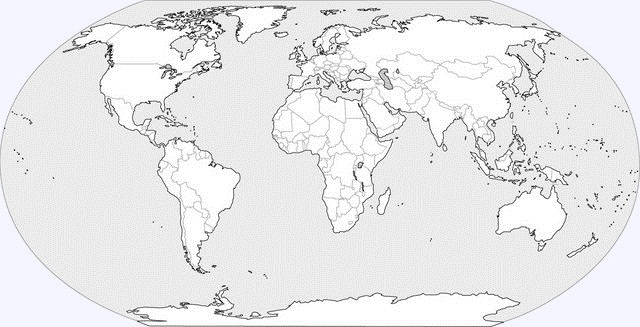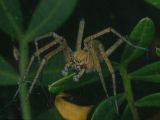|
Nombre común en ingles:
Daddy-long-legs spiders
Nombre común en castellano:
Se desconoce
Familias similares:
Género tipo:
Pholcus Walckenaer, 1805
Diagnosis:
Very small to medium-sized
araneomorph spiders; three tarsal claws; ecribellate; haplogyne; six
or eight eyes; clypeus about as high as chelicerae; legs usually
very long with pseudosegmented tarsi; chelicerae fused, with lamina,
modified in males; male palp with conspicuous procursus
(retrolateral paracymbium).
Caracteres descriptivos:
Caparazón:
short, broad and almost circular, sometimes reniform; cephalic
region usually raised, with deep striae; thoracic region sometimes
with deep, longitudinal fovea, except in ninetines and some
pholcines (e.g. Leptopholcus) in which carapace is depressed and
devoid of striae; clypeus about as high as length of chelicerae,
sometimes concave beneath eyes; pedicel dorsally with two chitinous
bands, parallel or V-shaped. Esternón:
flat or slightly convex; broadly truncated posteriorly. Ojos:
six or eight; often occupying entire width of carapace; anterior
median eyes smallest or absent, other eyes in two triads or on
tubercles. Quelíceros: chelate; weak and cylindrical in
shape; joined over greater part of length; cheliceral margin with
transparent lamina, apically thickened and darkened, lobed or
tooth-like, in male often with sexual dimorphic modifications. Piezas bucales:
labium fused to sternum, wider than long. Patas: three claws
with a very short, membranous onychium; legs often extremely long
and slender, rarely short (e.g. ninetines), with flexible tarsi;
tarsal organ exposed or capsulate. Palpo femenino:
usually small, slender and toothless. Abdomen: shape
variable, either globose or cylindrical to elongate (Leptopholcus);
epigastric region well developed; anal tubercle large, obtusely
triangular. Hileras:
anterior spinnerets thick and cylindrical, slightly separated:
posterior spinnerets smaller, conical and compressed; spigots rather
unusual with one huge and several smaller piriform gland spigots and
major ampullate gland spigot on the anterior lateral spinnerets;
distal ring of posterior median spinnerets composed of bases of two
spigots (one is the minor ampullate); no spigots on the posterior
lateral spinnerets. Sistema respiratorio:
two booklungs; tracheal spiracle lacking. Genitalia:
haplogyne; but female usually with an epigyne-like sclerotization
covering the internal female genitalia; male with large, complex
palpi; patella very small; tibia large and swollen, either oval or
globose; large paracymbium (procursus); bulbus divided into two
dissimilar parts; one part vesiculate, other part produced into a
long apophysis; cymbium with small alveolus, globose or oval. Tamaño corporal:
1-10 mm. Color: varies from cream with a few dark markings to
greyish brown with dark chevrons.
Estatus taxonómico:
Coddington & Levi (1991), Coddington et al. (2004) and Platnick et
al. (1991) placed the pholcids in the 'scytodoids' as sister-group
of the Digutidae. Plectreuridae. Scytodidae and Sicariidae, based on
the structure of the distal ring of the posterior median spinnerets
and reduction of the anterior median eyes. Major revisions by Huber
(2000, 2001, 2003a, b, c, 2005b).
Distribución: mundial.

Estilo de vida: Pholcids
construct sheet or spacewebs and are found in a wide variety of
habitats but frequently in dark places such as caves, under stones
and fallen long. Some species are synanthropic and cosmopolitan as a
result.
Bibliografía:
-
Bruvo-Madaric, B.,
Huber, B.A., Steinacher, A., Pass, G. 2005. Phylogeny of pholcid
spiders (Araneae: Pholcidae): combined analysis using morphology and
molecules. Mol. Phylogen. Evol. 37: 661-673.
-
Dippenaar-Schoeman, A.S. & Jocqué,
R. 1997. African Spiders: An Identification Manual. Plant Protection
Res. Inst. Handbook, no. 9, Pretoria, 392 pp.
-
Huber, B.A. 2000.
New World pholcid spiders (Araneae: Pholcidae): a revision at
generic level. Bull. Am. Mus. Nat. Hist. 254: 1-348.
-
Huber, B.A. 2003a.
Cladistic analysis of Malagasy pholcid spiders reveals generic level
endemism: Revision of Zatavua n. gen. and Paramicromerys Millot (Pholcidae,
Araneae). Zool. J. Linn. Soc. 137: 261-318.
-
Huber, B.A. 2003b.
High species diversity in one of the dominant groups of spiders in
East African montane forests (Araneae: Pholcidae: Buitinga n. gen.,
Spermophora Hentz). Zool. J. Linn. Soc. 137: 555-619.
-
Huber, B.A. 2003c.
Southern African pholcid spiders: revision and cladistic analysis of
Quamtana n. gen. and Spermophora Hentz (Araneae: Pholcidae), with
notes on male-female covariation. Zool. J. Linn. Soc. 139: 477-527.
-
Huber, B.A. 2005a.
The pholcid spiders of Africa (Araneae: Pholcidae): state of
knowledge and directions for future research. pp. 181-186 in:
African Biodiversity (Huber B. A., Sinclair B., Lampe K.-H. Eds.).
Springer Verlag, The Netherlands.
-
Huber, B.A. 2005b.
Revision of the genus Spermophora Hentz in Southeast Asia and on the
Pacific Islands, with descriptions of three new genera (Araneae:
Pholcidae). Zool. Mededelingen 79-2(4): 61-114.
-
Huber, B.A. 2005d.
Pholcidae. pp. 194-196 in Ubick, D., Paquin, P., Cushing, P.E. &
Roth, V. (Eds) 2005. The Spiders of North America. An Identification
Manual. American Arachnological Society.
5 géneros y 13 especies presentes en la Península Ibérica:
|
| |
- H. caudatus
(Dufour, 1820) |
| |
- H. hispanicus
Wiehle, 1933 |
| |
- H. pluchei
(Scopoli, 1763) |
|
| |
- P. opilionoides
(Schrank, 1781) |
| |
- P. plalangioides
(Fuesslin, 1775) |
|
| |
- P. simoni
(Berland, 1911) |
|
| |
- S. senoculata
(Dugès, 1836) |
|
| |
- S. elevata
(Simon, 1873) |
| |
- S. huberti
(Senglet, 1973) |
| |
- S. mammata
(Senglet, 1973) |
| |
- S. mediterranea
(Senglet, 1973) |
| |
- S. petraea
(Senglet, 1973) |
| |
- S. valentiana
(Senglet, 1973) |
| |
|
 |